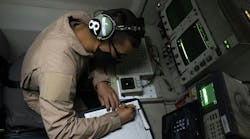Steve Rood Goldman is a product manager for high-speed networking at Data Device Corp. in Bohemia, N.Y. He has 15 years of product marketing experience in the networking, telecommunications, and semiconductor industries, and holds a bachelor of science degree in electrical engineering, as well as a master’s degree in management.
Q: DDC is leading efforts to design Ethernet and Gigabit Ethernet technology for military applications. Can you give two examples where this technology is implemented or being implemented in military applications?
A: Ethernet and Gigabit Ethernet is being deployed or implemented in a number of military systems including transport, reconnaissance, bomber, UAV, and rotary-wing aircraft; army ground vehicles; and multiple Navy vessels.
Q: Why Ethernet as opposed to other standards? What are the advantages?
A: The Department of Defense’s (DOD’s) Unmanned Aircraft System (UAS) Roadmap, 2005-2030, encourages the use of “common, network-enabled electrical interfaces such as Gigabit Ethernet.” There are several reasons for this mandate. Ethernet is mature technology with more than 200 million commercial ports sold in 2005 alone. Maturity has resulted in the wide availability of commercial-off-the-shelf (COTS) hardware and software, which has been adapted for military use. Ethernet’s growth in popularity both commercially and in military applications is driven in large part by its native support of IP networks. IP is important enabling technology for the Global Information Grid (GIG), which is the physical embodiment of the military’s network-centric warfare initiative.
Q: What are the main design challenges in adapting Gigabit Ethernet for military applications?
A: Military Ethernet equipment must perform over an extended-temperature range and often needs to operate in a packed chassis where conduction cooling is required. Switches and interface cards developed for telecom or data center applications often use controllers and physical-layer devices designed for commercial temperature ranges. Support for extended-temperature operation and conduction cooling must be designed in from the start, since it fundamentally impacts mechanical design and component selection.
Most computer systems use hardware to manage the physical- and link-layer network protocols for their Ethernet connections, while software handles the upper-level protocols, including TCP/IP and UDP/IP. For connections running at 100 Megabits per second or slower, especially for commercial applications where there is plenty of spare processor bandwidth, managing the upper-level protocols on the host system processor works well. The transition to Gigabit Ethernet in the military has introduced a challenge in handling the additional processing overhead of the TCP/IP and UDP/IP protocols. Military systems are less likely to have processor bandwidth to spare due to a combination of compute-intensive applications and power dissipation restrictions. Protocol offloading techniques offer a solution when boosting overall processor performance is impractical.
Q: Where do Ethernet and Gigabit Ethernet fall short? What are the technological challenges that still must be overcome?
A: IP-based Ethernet networks provide services on a “best effort” basis. This means that unless additional mechanisms are put in place, there are no inherent throughput or delay guarantees. This could be a problem on complex networks, shared by multiple applications with different service requirements. If, for example, real-time video traffic is sharing the same network with a file server, additional provisions must be made to prevent the latency-sensitive video packets from being delayed in an unpredictable way by file server transfers. IP provides a means of tagging traffic priority, but additional protocols are required to classify and manage the traffic.
One such protocol, called Differentiated Services, is used in commercial IP networks. DiffServ uses a small number of priority classes to allocate network bandwidth statistically. For military applications that need guaranteed delay bounds, another approach is needed. Integrated Services protocol is able to manage individual flows throughout the network. This approach requires that all routers on the network implement IntServ and store state information for each flow. As the network scales in size, the storage overhead increases. As a result, IntServ has not been a success for commercial networks, but may be applicable to closed military systems.
Redundancy management is another challenge for military systems using Ethernet. Existing protocols such as Rapid Spanning Tree Protocol (RSTP) and Link Aggregation Control Protocol (LACP) provide robust methods of providing redundancy for commercial networks. But these protocols take on the order of seconds to respond to link failures. Military systems require rapid recovery techniques to prevent data loss. Some commercial aircraft have been implementing networks based on ARINC-664, which is a variant of Ethernet. ARINC-664 provides robust dual-redundancy by simultaneously transmitting traffic on two independent paths. Errors are detected at the receiver, which can also identify and discard duplicate data packets. Error detection and recovery is entirely transparent to the network application. This form of redundancy could be adapted to military use if suitable equipment was made available.
Q: What are the obsolescence issues with Ethernet technology?
A: Unlike most networking technologies, Ethernet has been able to provide a backward-compatible replacement for itself every few years that offers a tenfold performance increase. Today, 1000Base-T connections are 100 times and 10 times faster than legacy 100Base-TX and 10Base-T connections, respectively. But a 1000Base-T network interface card can also communicate seamlessly with a 10/100 switch. Ethernet’s self-replacement capability is a powerful feature, but it does not eradicate obsolescence problems. For example, 1000Base-T requires different cabling than its predecessors to operate at gigabit speed. Likewise, for applications requiring fiber optic connections, 100Base-FX interfaces are incompatible with 1000Base-SX fiber.
Ethernet’s common set of protocols, and its widely-adopted BSD Sockets application interface, ensure that new equipment and applications will interoperate with existing systems.
Steve Rood Goldman, Product Manager for high-speed networking at Data Device Corp. in Bohemia, N.Y.




